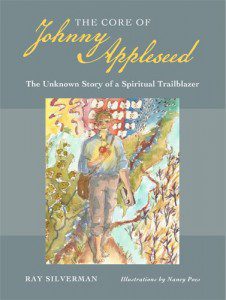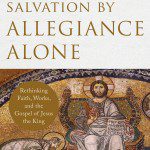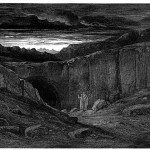This post is part of the Patheos Book Club roundtable discussion of The Core of Johnny Appleseed: The Unknown Story of a Spiritual Trailblazer by Ray Silverman.
When I heard that Ray Silverman (a former professor of mine at Bryn Athyn College) was publishing a book on Johnny Appleseed (or John Chapman, his real name), I have to admit that my first thought was, “Oh no – another one?” Maybe I’m hyper-aware of this as a Swedenborgian – since Johnny Appleseed and Helen Keller are the two most famous Swedenborgians in history – but there has been a lot written about Johnny Appleseed, especially given how little actual data we have on him. If you search amazon.com for books with “Johnny Appleseed” in the title, you get 464 results. That’s just books with the name in the title; it doesn’t include the countless tall tale collections and histories of folklore that include sections on Johnny Appleseed.
So, I wasn’t entirely sure the world needed another book on Johnny Appleseed. The one thing that encouraged me was that this book was written by a Swedenborgian scholar, and as such, would hopefully present an accurate picture of Chapman’s faith. And as it turns out, that is the book’s biggest strength, and the reason I’d probably recommend this book above others to someone looking for a brief introduction to the life of Johnny Appleseed.
Dr. Silverman divides his look at Johnny into three sections: “The Skin” (what people saw); “The Fruit” (what Johnny did); and “The Core” (who Johnny was). “The Core” is the section that interested me the most. Silverman suggests that Chapman’s legendary kindness and love of nature stemmed from his deep Swedenborgian belief in an all-loving God who reveals Himself in every detail of creation as well as in scripture. He shows from reports within the organized New Church (the church inspired by Swedenborg’s writings) that Chapman’s self-averred motivation in sowing apple orchards was to find opportunities to share the “good news fresh from heaven,” Swedenborg’s works. The most valuable part of the book is found in this section on “the core”: Silverman’s examination of commonly-repeated inaccuracies in descriptions of Chapman’s faith. (In a post last year, I noted several of these repeated by Howard Means in his book Johnny Appleseed: The Man, the Myth, the Legend; after posting that, I had an email exchange with Means in which he graciously explained the challenge of trying to include enough theology without losing the story, and so losing readers’ interest.) As Silverman explains, Chapman’s faith made it very unlikely a.) that he would have considered nature itself to be divine, b.) that he would have expected to marry multiple women in heaven, or c.) that he would have hoped to earn heaven by making himself miserable.
The explanations there are clear and concise. In fact, the whole book is concise – and I have to admit, I was a little bit disappointed in just how short it is. Excepting an FAQ section and the appendixes, it comes in at only 78 pages, with large margins and plenty of illustrations. The section on “The Core” takes up 25 of those pages – longer than any other section, but still short enough to leave me wanting more.
The problem, though, as Means pointed out in his book, is that there simply is not a lot of solid information on who Chapman was; and without that, it’s hard to go too in depth in exploring his faith.
Silverman’s book does a good job of dealing with what little information we do have, and as such, it’s a very good introduction for anyone unfamiliar with the true story of Johnny Appleseed – and probably the first one I’d recommend, since it corrects errors found in several other biographies. It’s not the in depth examination of Chapman’s spirituality that I’d still like to see, but given the dearth of information on his life, that book will almost certainly never be written.












